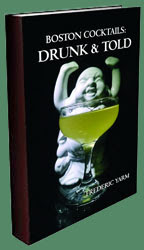
The theme for this month's
Mixology Monday (MxMo XXXVII) is "First Time" as chosen by the wonderful ladies of
LUPEC Boston. The concept was not to re-create your own possibly awkward stumblings into the world of cocktails but to initiate someone else properly with style and grace. LUPEC's Pink Lady writes, "What drink do you suggest for the delicate palate of the cocktail neophyte? Something boozy and balanced, sure - but one wrong suggestion could relegate the newbie to a beer-drinker's life. To which go-to cocktails do you turn to when faced with the challenge?"
Looking back at the beginning entries of my journal of all the drinks I have made at home, one of the ones that stood out was the Hoop La, the first drink we made with our then newly purchased bottle of brandy. The Hoop La is very similar to the other drink I thought of as a starting point, the Side Car -- one of the first brandy drinks I had out at a bar, except the Hoop La has an extra ingredient of Lillet Blanc in the mix to make it more sublime. Lillet with its rich bouquet of citrus peel and other fruit notes aids in softening the drink while also adding a depth of flavor relative to its cousin the Side Car.
Hoop La
• 3/4 oz Brandy
• 3/4 oz Cointreau
• 3/4 oz Lillet Blanc
• 3/4 oz Fresh Lemon Juice
Shake with ice and strain into a cocktail glass.
I am not sure of the history of the cocktail other than it first appeared in print in the 1930
Savoy Cocktail Book, but the combination must have been a very popular one for there are three other drinks I have found with the same ingredients and proportions: the Frank Sullivan, the Hey Hey, and the Odd McIntyre cocktails. I remember how I was fooled into making what I thought was a new to me cocktail recipe, a Frank Sullivan, and then discovering that it was the same cocktail as the Hoop La I had a few months prior.

There are several reasons why the Hoop La stands out as a good gateway cocktail. First, the base spirit is brandy. Brandy, unlike vodka, has a flavor; however, it is not as initially objectionable to a novice drinker as gin, tequila, or whiskey, so it is a good way to teach someone that boozes themselves can taste good and are not something that they should try to mask with various mixers. Second, the drink falls into the pleasing class of "sours" but is well balanced enough to be not puckery from the lemon juice and not overly sweet from the sugar source, here mainly the Cointreau, in this recipe. Third, the Lillet Blanc is an aromatized wine and this can teach drinkers that similar products, namely vermouths, can make drinks taste better and not worse (although perhaps not in the vodka
martinis cocktails they might have encountered in the past).
And lastly, the recipe is easy to learn (equal parts) and can easily be switched around to broaden one's drinking experience. For example, the Lillet can be swapped for rum or Calvados to make it a Between the Sheets or
Deauville Cocktail, respectively. Or the recipe can serve as a gateway to gin by swapping the brandy for gin and adding two drops of pastis to make a Corpse Reviver No. 2 (which turns out to be the cocktail
Paul Clarke chose for this MxMo). And to avoid the complications of the sometimes challenging anise flavors in the pastis, another gin possibility is to switch out both the brandy and Cointreau for gin and light crème de cacao (although double the gin proportion) to make the rather pleasing Twentieth Century Cocktail.
And to tie in the concept of making a drink for a cocktail virgin and Jess' original name of the blog (before she invited the rest of us on board), I went back in to her early entries and saw another drink that I thought of but passed on in favor of the Hoop La,
Elephants Sometimes Forget, a very delicious sour cherry cocktail that can serve as a tasty introduction to gin, vermouth, and bitters. While not her first cocktail, it was one of the first few that she made for herself, and one I would enthusiastically encourage others to try:
Elephants Sometimes Forget
• 1 oz Gin
• 3/4 oz Cherry Heering
• 3/4 oz Fresh Lemon Juice
• 1/4 oz Dry Vermouth
• 1 dash Orange Bitters
Shake with ice and strain into a cocktail glass.


 2 oz Laphroaig Cask Strength Scotch
2 oz Laphroaig Cask Strength Scotch

 The theme for this month's
The theme for this month's 
 2 parts Old Overholt Rye
2 parts Old Overholt Rye The 2017 collection of 855 drink recipes, bartender tributes, and essays on hospitality from CocktailVirgin's Frederic Yarm. Available at
The 2017 collection of 855 drink recipes, bartender tributes, and essays on hospitality from CocktailVirgin's Frederic Yarm. Available at  The 2012 collection of 505 drink recipes, techniques, and Boston bar recommendations from Frederic Yarm. Available at
The 2012 collection of 505 drink recipes, techniques, and Boston bar recommendations from Frederic Yarm. Available at 



